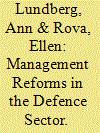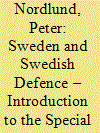| Srl | Item |
| 1 |
ID:
185479


|
|
|
|
|
| Summary/Abstract |
Extant theory suggests that paths of development, although identified as being unsustainable, might be difficult to depart from. The aim of this study has therefore been to explore and understand how a path change can be facilitated in a setting of complex product systems. A unique single case of product development that managed to curb an unsustainable intergenerational cost escalation for complex defence equipment has been studied. The study shows a relation between a path change and a challenging opportunity, and also indicates how this relation can be moderated by the company management and the customers. The study provides both theoretical and practical implications, supporting understanding and facilitation of path changes.
|
|
|
|
|
|
|
|
|
|
|
|
|
|
|
|
| 2 |
ID:
185477


|
|
|
|
|
| Summary/Abstract |
This article describes how Sweden developed a hybrid defence-industrial infrastructure with three prioritized ‘essential strategic interests’ pointing to parts of the domestic defence industry: ‘a partial strategic autonomy’. The article focuses on Sweden’s declared three essential security interests – combat aircraft capability; underwater capabilities; and integrity-critical parts of the command, control, communication and intelligence domain (C3I). The article finds that the possibilities and ways forward for the essential security interests vary, with a general trend towards more shared and increasingly partial autonomy. Six change factors are formulated as drivers towards Sweden’s partial strategic autonomy of today: Autonomy as a result of failed internationalization; Techno-nationalist perception of Sweden leading to industrial protectionism; Strategic choice; Corporate lobbying; Export incentives leading to political support of technologies; and Europeanization of the EU defence industry. Techno-nationalism and strategic choice are the factors with the most evident impact. The overall governance of the defence industry is clear on the priority of ensuring security of supply and a high degree of autonomy regarding the three essential security interests. Other parts of the defence industry operate under globalized and more competitive conditions. In order to apply increased economic rationality and strive for shared autonomy, Sweden must increase its engagement in multilateral arms collaboration.
|
|
|
|
|
|
|
|
|
|
|
|
|
|
|
|
| 3 |
ID:
185486


|
|
|
|
|
| Summary/Abstract |
While a great deal of research has examined determinants of military spending, few studies have systematically investigated how legislators vote on defense expenditures. This study fills this important gap. Based on a sample of roll-call data on defense spending from the 112th U.S. House, we estimate legislators’ ideal points through an item response model. Several interesting findings emerge. First, Republicans are more likely to favor military spending, a finding that is both statistically and substantively significant throughout our analysis. In addition, interest group campaign contributions play an important role by increasing the probability a legislator supports defense spending. Third, when a congressional district has a larger number of veterans or a lower rate of unemployment, its elected legislator is likely to favor military spending. Finally, the effect of public opinion disappears after the district demographics are controlled for.
|
|
|
|
|
|
|
|
|
|
|
|
|
|
|
|
| 4 |
ID:
185483


|
|
|
|
|
| Summary/Abstract |
The Swedish defence sector has for the last 30 years been subject to expenditure reductions and changed policy as well as management reforms inspired by the ideas of New Public Management (NPM). The purpose of this article is to provide insights into the major management reforms in the defence sector. We describe and discuss the reforms and the implications for the defence sector in the context of expenditure reductions and changed defence policy. We conclude that the earlier management reforms served as instruments to reduce defence expenditure and that the reforms have affected how agencies and the Government interact and how politicians are able to influence the sector. Furthermore, there are indications that these reforms have contributed to the management challenges we can observe in the defence sector today. These challenges correspond to important features of an efficient network. This implies that there might be a need of a different perspective to improve public management of the defence sector.
|
|
|
|
|
|
|
|
|
|
|
|
|
|
|
|
| 5 |
ID:
185488


|
|
|
|
|
| Summary/Abstract |
This paper constructs a theoretical model involving supply-side effect, demand-side effect, and security effect produced by military spending to explore the effects of military spending and foreign military threat on employment. This paper proves that the relationship between defense burden and employment is nonlinear (i.e., reverse U shape.). Hence, we find the defense burden of maximizing employment. In addition, we argue that a rise in foreign military threat will be detrimental to the level of output and in turn lead to a reduction in employment. Finally, we show that an increase in the variance of the foreign military spending shocks will raise the level of output and then lead to an increase in employment.
|
|
|
|
|
|
|
|
|
|
|
|
|
|
|
|
| 6 |
ID:
185484


|
|
|
|
|
| Summary/Abstract |
One of the outcomes of the 2014 North Atlantic Treaty Organization (NATO) Summit held in Wales was the recommendation that allies should strive towards spending at least 2% of their Gross Domestic Product (GDP) on military expenditure by 2024. This has in recent years put the debate on burden sharing within the Alliance in the limelight. Within the Alliance, the interpretation of the guidelines is different. This is partly because the U.S.A, especially under President Trump, has consistently viewed the 2-% guideline as a binding agreement. Some allies have, however, indicated that their military expenditure will not increase to the recommended threshold by the set deadline. Critics of the guideline have also identified several shortfalls associated with it and consequently dismissed it. Those who support it emphasize for instance that it contributes to addressing grievances about free riding within the Alliance. This paper contributes to this discussion and literature on demand for military expenditure by assessing how NATO’s two percent guideline can be viewed from a demand for military expenditure perspective. It also proposes and estimates a dynamic panel model for this purpose. Empirical evidence presented suggests that fiscal conditions require attention in the debate on the two percent guideline.
|
|
|
|
|
|
|
|
|
|
|
|
|
|
|
|
| 7 |
ID:
185487


|
|
|
|
|
| Summary/Abstract |
It is widely believed that Unmanned Aerial Systems (UASs) are less costly than comparable manned aircraft. However, the costs per flying hour frequently used to compare unmanned and manned aircraft only cover variable costs of aircraft operation. Variable costs per flying hour may overstate UASs’ cost advantage because they do not account for UASs having shorter life spans and being destroyed at higher rates than manned aircraft. In this note, we develop a lifecycle cost per flying hour that considers both acquisition and recurring costs while also accounting for UASs having shorter life spans and greater accidental destruction rates than manned aircraft. We compare unmanned United States Air Force RQ-4 to manned United States Navy P-8 costs using our methodology. While the RQ-4 has a variable cost per flying hour about 38% less than the P-8’s, we find that the RQ-4’s lifecycle cost per flying hour is about 17% less than the P-8’s.
|
|
|
|
|
|
|
|
|
|
|
|
|
|
|
|
| 8 |
ID:
185481


|
|
|
|
|
| Summary/Abstract |
This paper studies how local labour market conditions influence the quality composition of those who volunteer for military service in Sweden. A fixed-effects regression model is estimated on a panel data set containing IQ scores for those who applied for military basic training across Swedish municipalities during the period 2010 to 2016. The main finding is that low civilian employment rates at the local level tend to increase the mean IQ score of those who volunteer for military service, whereas the opposite is true if employment rates in the civilian labour market move in a more favourable direction. As such, the results suggest that the negative impact of a strong civilian economy on recruitment volumes is reinforced by a deterioration in recruit quality.
|
|
|
|
|
|
|
|
|
|
|
|
|
|
|
|
| 9 |
ID:
185476


|
|
|
|
|
| Summary/Abstract |
This article provides the context for the articles in this Special Issue on Sweden and its defence. The article starts with Sweden before presenting Swedish defence, its economy, the military threats, the defence industry, the personnel and the guiding principles of defence. Swedish principles for governance of the public agencies in general and within the defence sector in particular are described. A presentation of the Swedish Defence Research Institute (FOI) and its defence economic activities is also provided.
|
|
|
|
|
|
|
|
|
|
|
|
|
|
|
|